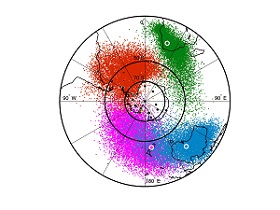PhD Defence Seminar: Antarctic and Southern Ocean Dust Transport Pathways: forward-Trajectory modeling and rare Earth element source constraints from the rice ice core
PhD Defence Seminar: Antarctic and Southern Ocean Dust Transport Pathways: forward-Trajectory modeling and rare Earth element source constraints from the rice ice core
Date: 17 June 2015 Time: 12.00 pmSpeaker: Geology PhD Candidate Peter Neff
 Mineral dust fertilization of Southern Ocean surface waters, and mixing with Antarctic deep-water, influences oceanic uptake of carbon dioxide and draws down global atmospheric concentrations during glacial periods. Sediment and ice core records demonstrate 25-fold dust flux changes between glacial and interglacial periods, but it is not known if individual records preserve material from one or many dust sources. First, using forward trajectory modeling, this work explores modern (1979-2013) modes of atmospheric transport from Southern Hemisphere mineral dust potential source areas (PSA)—primarily Australia, southern South America and southern Africa. Estimates of the relative atmospheric transport strength from New Zealand, likely a large dust source during glacial periods, are also discussed for the first time. Relative dust PSA contributions are detailed for Antarctic ice core sites, including the newly recovered Roosevelt Island Climate Evolution (RICE) ice core (79.36ºS, 161.71ºW, 550 m a.s.l.). This approach suggests that atmospheric transport of dust and other aerosols from New Zealand to the Antarctic may equal that of Patagonia. On inter-annual timescales it also reveals the influence of tropical and high-latitude climate variability on potential atmospheric transport of material to the Southern Ocean and Antarctica.
Mineral dust fertilization of Southern Ocean surface waters, and mixing with Antarctic deep-water, influences oceanic uptake of carbon dioxide and draws down global atmospheric concentrations during glacial periods. Sediment and ice core records demonstrate 25-fold dust flux changes between glacial and interglacial periods, but it is not known if individual records preserve material from one or many dust sources. First, using forward trajectory modeling, this work explores modern (1979-2013) modes of atmospheric transport from Southern Hemisphere mineral dust potential source areas (PSA)—primarily Australia, southern South America and southern Africa. Estimates of the relative atmospheric transport strength from New Zealand, likely a large dust source during glacial periods, are also discussed for the first time. Relative dust PSA contributions are detailed for Antarctic ice core sites, including the newly recovered Roosevelt Island Climate Evolution (RICE) ice core (79.36ºS, 161.71ºW, 550 m a.s.l.). This approach suggests that atmospheric transport of dust and other aerosols from New Zealand to the Antarctic may equal that of Patagonia. On inter-annual timescales it also reveals the influence of tropical and high-latitude climate variability on potential atmospheric transport of material to the Southern Ocean and Antarctica.
 High-resolution sampling of the RICE ice core allows for analysis of trace elements at sub-annual to annual scales. Rare earth element (REE, Lanthanum to Lutetium) concentrations of dust particles preserved in the ice retain signatures of dust sources and thus provide provenance constraints—especially when combined with results of the forward trajectory experiment. Measurements of REE have been made to the single femtogram per gram (10-15 g g-1) level, through efficient sample introduction and a jet-interface sector-field inductively coupled plasma mass spectrometer. Twentieth-century and late-Holocene (2.3 ka BP – present) REE data from the RICE ice core suggest no more than a 5% contribution of dust from Patagonia, which has long been favored as the dominant dust source for Antarctic ice cores. The data also show strong negative trends in REE signatures, suggesting significant influence of local Antarctic dust sources.
High-resolution sampling of the RICE ice core allows for analysis of trace elements at sub-annual to annual scales. Rare earth element (REE, Lanthanum to Lutetium) concentrations of dust particles preserved in the ice retain signatures of dust sources and thus provide provenance constraints—especially when combined with results of the forward trajectory experiment. Measurements of REE have been made to the single femtogram per gram (10-15 g g-1) level, through efficient sample introduction and a jet-interface sector-field inductively coupled plasma mass spectrometer. Twentieth-century and late-Holocene (2.3 ka BP – present) REE data from the RICE ice core suggest no more than a 5% contribution of dust from Patagonia, which has long been favored as the dominant dust source for Antarctic ice cores. The data also show strong negative trends in REE signatures, suggesting significant influence of local Antarctic dust sources.
